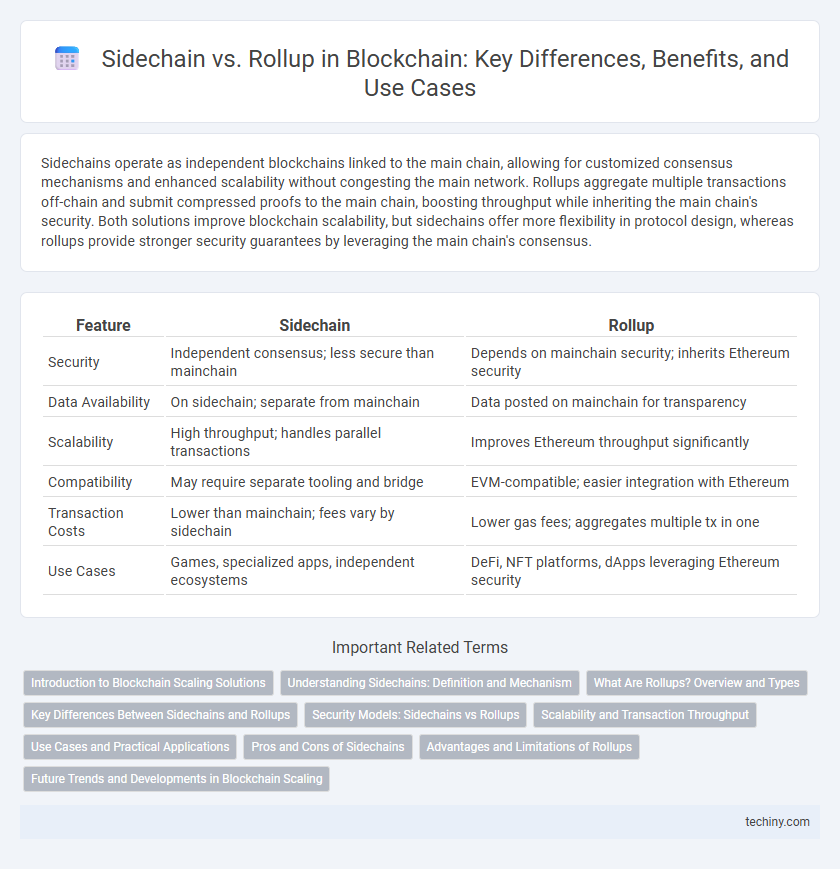Sidechains operate as independent blockchains linked to the main chain, allowing for customized consensus mechanisms and enhanced scalability without congesting the main network. Rollups aggregate multiple transactions off-chain and submit compressed proofs to the main chain, boosting throughput while inheriting the main chain's security. Both solutions improve blockchain scalability, but sidechains offer more flexibility in protocol design, whereas rollups provide stronger security guarantees by leveraging the main chain's consensus.
Table of Comparison
| Feature | Sidechain | Rollup |
|---|---|---|
| Security | Independent consensus; less secure than mainchain | Depends on mainchain security; inherits Ethereum security |
| Data Availability | On sidechain; separate from mainchain | Data posted on mainchain for transparency |
| Scalability | High throughput; handles parallel transactions | Improves Ethereum throughput significantly |
| Compatibility | May require separate tooling and bridge | EVM-compatible; easier integration with Ethereum |
| Transaction Costs | Lower than mainchain; fees vary by sidechain | Lower gas fees; aggregates multiple tx in one |
| Use Cases | Games, specialized apps, independent ecosystems | DeFi, NFT platforms, dApps leveraging Ethereum security |
Introduction to Blockchain Scaling Solutions
Sidechains and rollups offer distinct blockchain scaling solutions that enhance transaction throughput and reduce fees. Sidechains operate as independent blockchains linked to the main chain, allowing asset transfers and parallel processing without congesting the mainnet. Rollups, including Optimistic and ZK-rollups, bundle multiple transactions off-chain and submit compressed proofs to the mainchain, significantly increasing scalability while maintaining security.
Understanding Sidechains: Definition and Mechanism
Sidechains are independent blockchain networks running parallel to a main blockchain, allowing assets to be transferred between chains using a two-way peg mechanism. They enhance scalability and enable experimentation with different consensus algorithms without compromising the security of the main chain. Sidechains operate autonomously, processing transactions off the main blockchain while maintaining interoperability through cryptographic proofs.
What Are Rollups? Overview and Types
Rollups are Layer 2 scaling solutions that execute transactions off the main Ethereum chain while posting transaction data on-chain to ensure security and decentralization. They come in two primary types: Optimistic Rollups, which assume transactions are valid and use fraud proofs to challenge incorrect transactions, and ZK-Rollups, which generate zero-knowledge proofs to verify transaction validity instantly. Both types significantly increase transaction throughput and reduce gas fees without compromising the security of the base layer.
Key Differences Between Sidechains and Rollups
Sidechains operate as independent blockchains connected to the main chain, enabling custom consensus mechanisms and faster transactions, while rollups batch multiple transactions off-chain and submit compressed data to the main chain for verification, enhancing scalability and security. Sidechains maintain their own security models, potentially increasing risk, whereas rollups rely on the main chain's security, offering stronger protection against fraud and censorship. The primary distinction lies in security dependency and data availability, with rollups anchoring on-layer 1 security and sidechains functioning with independent consensus.
Security Models: Sidechains vs Rollups
Sidechains operate independently with their own consensus mechanisms, which can introduce higher security risks due to dependence on separate validators outside the main chain. Rollups inherit the main chain's security by posting transaction data and proofs on Layer 1, significantly reducing the attack surface. Optimistic rollups rely on fraud proofs, while zk-rollups use zero-knowledge proofs, both enhancing security compared to sidechains.
Scalability and Transaction Throughput
Sidechains enhance scalability by processing transactions on a separate blockchain, reducing mainnet congestion while enabling higher transaction throughput through parallel processing. Rollups increase scalability by aggregating multiple transactions off-chain and submitting a single compressed proof to the main chain, significantly boosting throughput and lowering gas fees. Both solutions address blockchain scalability challenges but differ in security trade-offs and data availability models.
Use Cases and Practical Applications
Sidechains enable independent blockchains to process transactions off the main chain, ideal for applications requiring custom assets and governance such as gaming platforms and enterprise solutions. Rollups bundle multiple transactions into a single batch on the main Ethereum chain, significantly reducing fees and increasing throughput, making them suitable for DeFi platforms and high-frequency trading. Both technologies enhance scalability but cater to distinct use cases: sidechains offer autonomy and flexibility, while rollups prioritize security and seamless integration with Ethereum.
Pros and Cons of Sidechains
Sidechains offer enhanced scalability by processing transactions independently while maintaining interoperability with the main blockchain, which reduces congestion but introduces potential security risks due to reliance on separate consensus mechanisms. They enable customized features and faster transaction speeds, making them suitable for specific applications, yet they often lack the robust security guarantees inherent to mainnet transactions. The trade-off between flexibility and security remains a critical consideration when choosing sidechains for blockchain scalability solutions.
Advantages and Limitations of Rollups
Rollups enhance blockchain scalability by processing transactions off-chain while maintaining security through on-chain data availability, significantly reducing fees and increasing throughput compared to sidechains. They offer compatibility with Ethereum's security model, ensuring decentralized consensus and minimizing trust assumptions often required by sidechains. Limitations include data availability challenges and potential congestion on the main chain, which can affect latency and finality times.
Future Trends and Developments in Blockchain Scaling
Sidechains and rollups represent pivotal solutions in blockchain scaling, with future trends indicating increased interoperability and security enhancements. Sidechains will continue evolving to support diverse functionalities and customized consensus mechanisms, while rollups, especially zk-rollups, are poised to achieve higher throughput and privacy improvements. Emerging developments emphasize seamless integration with mainchains to reduce latency and optimize transaction costs, driving mass adoption of scalable decentralized applications.
Sidechain vs Rollup Infographic

 techiny.com
techiny.com